Alternative Method for Determination of Vibroacoustic Material Parameters for Building Applications
Abstract
:1. Introduction
2. Measurement Methodology and Setup
2.1. Dynamic Stiffness and Critical Damping Factor Estimation with Reference Method
2.2. Alteranative Method
3. Results
4. Discussion
4.1. Dependencies between Relative Indentation and Dynamic Stiffness
4.2. Dependencies between Relative Rebound and Critical Damping Factor
4.3. Reference Method—Density, Dynamic Stiffness, and Critical Damping Factor
4.4. Reference Method—Rayleigh Damping
5. Conclusions
General Conclusions and Further Studies
Author Contributions
Funding
Institutional Review Board Statement
Informed Consent Statement
Data Availability Statement
Acknowledgments
Conflicts of Interest
References
- Liu, S.; Jia, L.; Zhang, F.; Wang, R.; Liu, X.; Zou, L.; Tang, X. Do New Urbanization Policies Promote Sustainable Urbanization? Evidence from China’s Urban Agglomerations. Land 2024, 13, 412. [Google Scholar] [CrossRef]
- Abulimiti, A.; Liu, Y.; Yang, L.; Abulikemu, A.; Mamitimin, Y.; Yuan, S.; Enwer, R.; Li, Z.; Abuduaini, A.; Kadier, Z. Urbanization Effect on Changes in Extreme Climate Events in Urumqi, China, from 1976 to 2018. Land 2024, 13, 285. [Google Scholar] [CrossRef]
- Boanada-Fuchs, A.; Kuffer, M.; Samper, J. A Global Estimate of the Size and Location of Informal Settlements. Urban. Sci. 2024, 8, 18. [Google Scholar] [CrossRef]
- Ge, S.; Zhan, W.; Wang, S.; Du, H.; Liu, Z.; Wang, C.; Wang, C.; Jiang, S.; Dong, P. Spatiotemporal Heterogeneity in Global Urban Surface Warming. Remote Sens. Environ. 2024, 305, 114081. [Google Scholar] [CrossRef]
- Bian, H.; Gao, J.; Liu, Y.; Yang, D.; Wu, J. China’s Safe and Just Space during 40 Years of Rapid Urbanization and Changing Policies. Landsc. Ecol. 2024, 39, 74. [Google Scholar] [CrossRef]
- Turemuratov, O.; Byulegenova, B.; Pogodin, S.; Onuchko, M.; Nurtazina, R. Urbanization Trends in Central Asian Countries: Aspects of Extensive and Intensive Agglomeration Growth. Public Organ. Rev. 2024. [Google Scholar] [CrossRef]
- Chanieabate, M.; He, H.; Guo, C.; Abrahamgeremew, B.; Huang, Y. Examining the Relationship between Transportation Infrastructure, Urbanization Level and Rural-Urban Income Gap in China. Sustainability 2023, 15, 8410. [Google Scholar] [CrossRef]
- Mwanzu, A.; Nguyu, W.; Nato, J.; Mwangi, J. Promoting Sustainable Environments through Urban Green Spaces: Insights from Kenya. Sustainability 2023, 15, 11873. [Google Scholar] [CrossRef]
- Aguilera, M.A.; González, M.G. Urban Infrastructure Expansion and Artificial Light Pollution Degrade Coastal Ecosystems, Increasing Natural-to-Urban Structural Connectivity. Landsc. Urban. Plan. 2023, 229, 104609. [Google Scholar] [CrossRef]
- Dalla Longa, R. Urban Infrastructures. In Urban Infrastructure; Springer International Publishing: Cham, Switzerland, 2023; pp. 1–42. [Google Scholar]
- Nicoletti, L.; Sirenko, M.; Verma, T. Disadvantaged Communities Have Lower Access to Urban Infrastructure. Environ. Plan. B Urban. Anal. City Sci. 2023, 50, 831–849. [Google Scholar] [CrossRef]
- Logachev, M.; Zhukova, G. Parametric Modeling of Traffic Flows for Predicting Sustainable Development of Urban Areas. BIO Web Conf. 2024, 83, 05002. [Google Scholar] [CrossRef]
- Martínez-Corral, A.; Cárcel-Carrasco, J.; Fonseca, F.C.; Kannampallil, F.F. Urban–Spatial Analysis of European Historical Railway Stations: Qualitative Assessment of Significant Cases. Buildings 2023, 13, 226. [Google Scholar] [CrossRef]
- Ahac, M.; Ahac, S.; Majstorović, I.; Stepan, Ž. Contribution to Rail System Revitalization, Development, and Integration Projects Evaluation: A Case Study of the Zadar Urban Area. Infrastructures 2024, 9, 32. [Google Scholar] [CrossRef]
- Megna, G.; Governi, L.; Carfagni, M.; Borchi, F.; Puggelli, L.; Buonamici, F. State of the Art about Solutions for Tram Noise Reduction in the Framework of the Life SNEAK Project. In Proceedings of the INTER-NOISE and NOISE-CON Congress and Conference Proceedings, Grand Rapids, MI, USA, 15–18 May 2023; Volume 265, pp. 6302–6313. [Google Scholar] [CrossRef]
- Khan, I.; Khattak, K.; Khan, Z.H.; Gulliver, T.A. Impact of Road Pavement Condition on Vehicular Free Flow Speed, Vibration and In-Vehicle Noise. Sci. Eng. Technol. 2023, 3, 1–8. [Google Scholar] [CrossRef]
- Khan, D.; Burdzik, R. Measurement and Analysis of Transport Noise and Vibration: A Review of Techniques, Case Studies, and Future Directions. Measurement 2023, 220, 113354. [Google Scholar] [CrossRef]
- Liu, Q.; Xu, L.; Feng, Q. Intelligent Monitoring of Vibration and Structural-Borne Noise Induced by Rail Transit. Intell. Transp. Infrastruct. 2023, 2, liad013. [Google Scholar] [CrossRef]
- Kawecki, J.; Kowalska, A. Analysis of Vibration Influence on People in Buildings in Standards Approach. WIT Trans. Ecol. Environ. 2011, 148, 355–366. [Google Scholar]
- Kowalska-Koczwara, A. Influence of Location of Measurement Point on Evaluation of Human Perception of Vibration. J. Meas. Eng. 2019, 7, 147–154. [Google Scholar] [CrossRef]
- Nering, K.; Kowalska-Koczwara, A.; Stypuła, K. Annoyance Based Vibro-Acoustic Comfort Evaluation of as Summation of Stimuli Annoyance in the Context of Human Exposure to Noise and Vibration in Buildings. Sustainability 2020, 12, 9876. [Google Scholar] [CrossRef]
- Fedorczak-Cisak, M.; Kowalska-Koczwara, A.; Nering, K.; Pachla, F.; Radziszewska-Zielina, E.; Śladowski, G.; Tatara, T.; Ziarko, B. Evaluation of the Criteria for Selecting Proposed Variants of Utility Functions in the Adaptation of Historic Regional Architecture. Sustainability 2019, 11, 1094. [Google Scholar] [CrossRef]
- Güneralp, B.; Reba, M.; Hales, B.U.; Wentz, E.A.; Seto, K.C. Trends in Urban Land Expansion, Density, and Land Transitions from 1970 to 2010: A Global Synthesis. Environ. Res. Lett. 2020, 15, 044015. [Google Scholar] [CrossRef]
- Chakraborty, S.; Maity, I.; Dadashpoor, H.; Novotnẏ, J.; Banerji, S. Building in or out? Examining Urban Expansion Patterns and Land Use Efficiency across the Global Sample of 466 Cities with Million+ Inhabitants. Habitat. Int. 2022, 120, 102503. [Google Scholar] [CrossRef]
- Amen, M.A.; Afara, A.; Nia, H.A. Exploring the Link between Street Layout Centrality and Walkability for Sustainable Tourism in Historical Urban Areas. Urban. Sci. 2023, 7, 67. [Google Scholar] [CrossRef]
- McDonald, R.I.; Aronson, M.F.J.; Beatley, T.; Beller, E.; Bazo, M.; Grossinger, R.; Jessup, K.; Mansur, A.V.; Puppim de Oliveira, J.A.; Panlasigui, S.; et al. Denser and Greener Cities: Green Interventions to Achieve Both Urban Density and Nature. People Nat. 2023, 5, 84–102. [Google Scholar] [CrossRef]
- He, X.; Yu, Y.; Jiang, S. City Centrality, Population Density and Energy Efficiency. Energy Econ. 2023, 117, 106436. [Google Scholar] [CrossRef]
- Goda, T.; Stewart, C.; Torres García, A. Absolute Income Inequality and Rising House Prices. Socioecon. Rev. 2021, 18, 941–976. [Google Scholar] [CrossRef]
- Kettunen, H.; Ruonavaara, H. Rent Regulation in 21st Century Europe. Comparative Perspectives. Hous. Stud. 2021, 36, 1446–1468. [Google Scholar] [CrossRef]
- Manting, D.; Kleinepier, T.; Lennartz, C. Housing Trajectories of EU Migrants: Between Quick Emigration and Shared Housing as Temporary and Long-Term Solutions. Hous. Stud. 2024, 39, 1027–1048. [Google Scholar] [CrossRef]
- Andargie, M.S.; Touchie, M.; O’Brien, W. Case Study: A Survey of Perceived Noise in Canadian Multi-Unit Residential Buildings to Study Long-Term Implications for Widespread Teleworking. Build. Acoust. 2021, 28, 443–460. [Google Scholar] [CrossRef]
- Lee, P.J.; Jeong, J.H. Attitudes towards Outdoor and Neighbour Noise during the COVID-19 Lockdown: A Case Study in London. Sustain. Cities Soc. 2021, 67, 102768. [Google Scholar] [CrossRef]
- Deaconu, M.; Cican, G.; Cristea, L. Noise Impact Mitigation of Shopping Centres Located near Densely Populated Areas for a Better Quality of Life. Appl. Sci. 2020, 10, 6484. [Google Scholar] [CrossRef]
- Directive 2002/49/EC of the European Parliament and of the Council of 25 June 2002 Relating to the Assessment and Management of Environmental Noise—Declaration by the Commission in the Conciliation Committee on the Directive Relating to the Assessment and Management of Environmental Noise. Available online: https://eur-lex.europa.eu/LexUriServ/LexUriServ.do?uri=CELEX:32002L0049:EN:HTML (accessed on 1 December 2022).
- Noise Control Act of 1972, P.L. 92-574, 86 Stat. 1234. Available online: https://www.gsa.gov/system/files/Noise_Control_Act_of_1972.pdf (accessed on 1 December 2022).
- ISO 9612:2009; Acoustics—Determination of Occupational Noise Exposure—Engineering Method. ISO: Geneva, Switzerland, 2009.
- ISO 2631-1:1997; Evaluation of Human Exposure to Whole-Body Vibration. ISO: Geneva, Switzerland, 1997.
- ISO 16032:2004; Acoustics—Measurement of Sound Pressure Level from Service Equipment in Buildings—Engineering Method. ISO: Geneva, Switzerland, 2004.
- ISO 2631-1:1985; Evaluation of Human Exposure to Whole-Body Vibration Part 1: General Requirements. ISO: Geneva, Switzerland, 1958.
- ISO 12354-2:2017; Building Acoustics—Estimation of Acoustic Performance of Buildings from the Performance of Elements—Part 2: Impact Sound Insulation between Rooms. ISO: Geneva, Switzerland, 2017.
- ISO 12354-1:2017; Building Acoustics—Estimation of Acoustic Performance of Buildings from the Performance of Elements—Part 1: Airborne Sound Insulation between Rooms. ISO: Geneva, Switzerland, 2017.
- ISO 6897:1984; Guidelines for the Evaluation of the Response of Occupants of Fixed Structures, Especially Buildings and off-Shore Structures, to Low Frequency Horizontal Motion (0.063 to 1 Hz). ISO: Geneva, Switzerland, 1984.
- Howarth, H.V.C.; Griffin, M.J. The Annoyance Caused by Simultaneous Noise and Vibration from Railways. J. Acoust. Soc. Am. 1991, 89, 2317–2323. [Google Scholar] [CrossRef]
- Howarth, H.V.C.; Griffin, M.J. The Relative Importance of Noise and Vibration from Railways. Appl. Ergon. 1990, 21, 129–134. [Google Scholar] [CrossRef]
- Öhrström, E.; Skånberg, A.B. A Field Survey on Effects of Exposure to Noise and Vibration from Railway Traffic, Part I: Annoyance and Activity Disturbance Effects. J. Sound. Vib. 1996, 193, 39–47. [Google Scholar] [CrossRef]
- Wrótny, M.; Bohatkiewicz, J. Impact of Railway Noise on People Based on Strategic Acoustic Maps. Sustainability 2020, 12, 5637. [Google Scholar] [CrossRef]
- Kowalska-Koczwara, A.; Pachla, F.; Nering, K. Environmental Protection Against Noise and Vibration. IOP Conf. Ser. Mater. Sci. Eng. 2021, 1203, 032026. [Google Scholar] [CrossRef]
- EN 29052-1:2011/ISO 9052-1; Acoustics—Determination of Dynamic Stiffness—Part 1: Materials Used under Floating Floors in Dwellings. Available online: https://Standards.Iteh.Ai/Catalog/Standards/Cen/04a2dad0-Ff01-4409-B2d4-6d6d62feb5c7/En-29052-1-1992 (accessed on 1 December 2022).
- Kumar, D.; Alam, M.; Zou, P.X.W.; Sanjayan, J.G.; Memon, R.A. Comparative Analysis of Building Insulation Material Properties and Performance. Renew. Sustain. Energy Rev. 2020, 131, 110038. [Google Scholar] [CrossRef]
- He, Y.; Zhang, Y.; Yao, Y.; He, Y.; Sheng, X. Review on the Prediction and Control of Structural Vibration and Noise in Buildings Caused by Rail Transit. Buildings 2023, 13, 2310. [Google Scholar] [CrossRef]
- Chapain, S.; Aly, A.M. Vibration Attenuation in a High-Rise Hybrid-Timber Building: A Comparative Study. Appl. Sci. 2023, 13, 2230. [Google Scholar] [CrossRef]
- Jang, E.-S. Sound Absorbing Properties of Selected Green Material—A Review. Forests 2023, 14, 1366. [Google Scholar] [CrossRef]
- Kang, C.-W.; Jang, S.-S.; Hashitsume, K.; Kolya, H. Estimation of Impact Sound Reduction by Wood Flooring Installation in a Wooden Building in Korea. J. Build. Eng. 2023, 64, 105708. [Google Scholar] [CrossRef]
- Butorina, M.; Kuklin, D.; Drozdova, L. Application of Soundproof Planning to Reduce Noise in Residential Building. IOP Conf. Ser. Earth Environ. Sci. 2021, 666, 042006. [Google Scholar] [CrossRef]
- Sahana, S.; Karthigayini, S. Design Strategies to Reduce the Impact of Visual and Noise Pollution in Urban Areas. Asian Rev. Environ. Earth Sci. 2020, 7, 67–71. [Google Scholar] [CrossRef]
- Ouakka, S.; Verlinden, O.; Kouroussis, G. Railway Ground Vibration and Mitigation Measures: Benchmarking of Best Practices. Railw. Eng. Sci. 2022, 30, 1–22. [Google Scholar] [CrossRef]
- He, W.; Zou, C.; Pang, Y.; Wang, X. Environmental Noise and Vibration Characteristics of Rubber-Spring Floating Slab Track. Environ. Sci. Pollut. Res. 2021, 28, 13671–13689. [Google Scholar] [CrossRef] [PubMed]
- Deng, S.; Ren, J.; Zhang, K.; Xiao, Y.; Liu, J.; Du, W.; Ye, W.-L. Performance of Floating Slab Track with Rubber Vibration Isolator. Int. J. Struct. Stab. Dyn. 2024, 24, 2450065. [Google Scholar] [CrossRef]
- Malmborg, J.; Flodén, O.; Persson, P.; Persson, K. Numerical Study on Train-Induced Vibrations: A Comparison of Timber and Concrete Buildings. Structures 2024, 62, 106215. [Google Scholar] [CrossRef]
- Ming, X.; Zheng, J.; Wang, L.; Zhao, C.; Wang, P.; Yao, L. A Case Study of Excessive Vibrations inside Buildings Due to an Underground Railway: Experimental Tests and Theoretical Analysis. J. Cent. South. Univ. 2022, 29, 313–330. [Google Scholar] [CrossRef]
- López-Mendoza, D.; Connolly, D.P.; Romero, A.; Kouroussis, G.; Galvín, P. A Transfer Function Method to Predict Building Vibration and Its Application to Railway Defects. Constr. Build. Mater. 2020, 232, 117217. [Google Scholar] [CrossRef]
- He, C.; Zhou, S.; Guo, P. An Efficient Three-Dimensional Method for the Prediction of Building Vibrations from Underground Railway Networks. Soil Dyn. Earthq. Eng. 2020, 139, 106269. [Google Scholar] [CrossRef]
- Hao, Y.; Qi, H.; Liu, S.; Nian, V.; Zhang, Z. Study of Noise and Vibration Impacts to Buildings Due to Urban Rail Transit and Mitigation Measures. Sustainability 2022, 14, 3119. [Google Scholar] [CrossRef]
- Zheng, J.; Li, X.; Zhang, X.; Bi, R.; Qiu, X. Structure-Borne Noise of Fully Enclosed Sound Barriers Composed of Engineered Cementitious Composites on High-Speed Railway Bridges. Appl. Acoust. 2022, 192, 108705. [Google Scholar] [CrossRef]
- Sadeghi, J.; Vasheghani, M. Safety of Buildings against Train Induced Structure Borne Noise. Build. Environ. 2021, 197, 107784. [Google Scholar] [CrossRef]
- Sadeghi, J.; Vasheghani, M.; Khajehdezfuly, A. Propagation of Structure-Borne Noise in Building Adjacent to Subway Lines. Constr. Build. Mater. 2023, 401, 132765. [Google Scholar] [CrossRef]
- Nering, K. Perception of Structure-Borne Sound in Buildings in Context of Vibration Comfort of Human in the Buildings. IOP Conf. Ser. Mater. Sci. Eng. 2020, 960, 022033. [Google Scholar] [CrossRef]
- Wang, S.; Su, D.; Zhu, S.; Zhang, Q. Comparative Life Cycle Assessment of Raised Flooring Products. In Sustainable Product Development; Springer International Publishing: Cham, Switzerland, 2020; pp. 293–310. [Google Scholar]
- Kudryavtsev, M. Experimental Evaluation of the Seismic Resistance of the Raised Floor Structure; AIP Publishing: Long Island, NY, USA, 2023; p. 060007. [Google Scholar]
- Wang, J.; Du, B. Sound Insulation Performance of Foam Rubber Damping Pad and Polyurethane Foam Board in Floating Floors. Exp. Tech. 2023, 47, 839–850. [Google Scholar] [CrossRef]
- Scoczynski Ribeiro, R.; Henneberg, F.; Catai, R.; Arnela, M.; Avelar, M.; Amarilla, R.S.D.; Wille, V. Assessing Impact Sound Insulation in Floating Floors Assembled from Construction and Demolition Waste. Constr. Build. Mater. 2024, 416, 135196. [Google Scholar] [CrossRef]
- Crispin, C.; Dijckmans, A.; Wuyts, D.; Prato, A.; Rizza, P.; Schiavi, A. Analytical Prediction of Floating Floors Impact Sound Insulation Including Thickness-Resonance Wave Effects. Appl. Acoust. 2023, 208, 109380. [Google Scholar] [CrossRef]
- Schoenwald, S.; Vallely, S. Cross Laminated Timber Elements with Functional Grading and Localised Ballast to Improve Airborne and Impact Sound Insulation. In Proceedings of the 10th Convention of the European Acoustics Association Forum Acusticum 2023, Turin, Italy, 17 January 2024; European Acoustics Association: Turin, Italy; pp. 1529–1534. [Google Scholar]
- Nilsson, E.; Ménard, S.; Bard, D.; Hagberg, K. Effects of Building Height on the Sound Transmission in Cross-Laminated Timber Buildings—Airborne Sound Insulation. Build. Environ. 2023, 229, 109985. [Google Scholar] [CrossRef]
- Mateus, D.; Pereira, A. The Strong Influence of Small Construction Errors on Sound Insulation of Buildings with Heavyweight Concrete Structure: A Portuguese Case Study. Build. Acoust. 2023, 30, 227–246. [Google Scholar] [CrossRef]
- Fedorczak-Cisak, M.; Kowalska-Koczwara, A.; Nering, K.; Pachla, F.; Radziszewska-Zielina, E.; Stecz, P.; Tatara, T.; Jeleński, T. Measurement and Diagnosis of Comfort in a Historic Building. Energies 2022, 15, 8963. [Google Scholar] [CrossRef]
- Papadakis, N.; Katsaprakakis, D.A.l. A Review of Energy Efficiency Interventions in Public Buildings. Energies 2023, 16, 6329. [Google Scholar] [CrossRef]
- Amanowicz, Ł.; Ratajczak, K.; Dudkiewicz, E. Recent Advancements in Ventilation Systems Used to Decrease Energy Consumption in Buildings—Literature Review. Energies 2023, 16, 1853. [Google Scholar] [CrossRef]
- Tognon, G.; Marigo, M.; De Carli, M.; Zarrella, A. Mechanical, Natural and Hybrid Ventilation Systems in Different Building Types: Energy and Indoor Air Quality Analysis. J. Build. Eng. 2023, 76, 107060. [Google Scholar] [CrossRef]
- Abramkina, D. Noise from Mechanical Ventilation Systems in Residential Buildings. In E3S Web of Conferences; EDP Sciences: Les Ulis, France, 2023; Volume 457, p. 02007. [Google Scholar] [CrossRef]
- Zekic, S.; Gomez-Agustina, L.; Aygun, H.; Chaer, I. Experimental Acoustic Testing of Alternative Ventilation Ducts. In Proceedings of the INTER-NOISE and NOISE-CON Congress and Conference Proceedings, Grand Rapids, MI, USA, 15–18 May 2023; Volume 265, pp. 2785–2792. [Google Scholar] [CrossRef]
- Nering, K.; Kowalska-Koczwara, A.; Shymanska, A.; Pawluś, M. The Possibility of Providing Acoustic Comfort in Hotel Rooms as an Element of Sustainable Development. Sustainability 2022, 14, 13692. [Google Scholar] [CrossRef]
- Nalls, L.; Daroux, P. Case Study: Effect of Mechanical Short-Circuiting of Isolation Pads on Rooftop Equipment Noise and Vibration Transfer to Spaces Below. In Proceedings of the INTER-NOISE and NOISE-CON Congress and Conference Proceedings, Grand Rapids, MI, USA, 15–18 May 2023; Volume 266, pp. 234–242. [Google Scholar] [CrossRef]
- Mak, C.M.; Ma, K.W.; Wong, H.M. Prediction and Control of Noise and Vibration from Ventilation Systems; CRC Press: Boca Raton, FL, USA, 2023; ISBN 9781003201168. [Google Scholar]
- Ruggieri, S.; Vukobratović, V. The Influence of Torsion on Acceleration Demands in Low-Rise RC Buildings. Bull. Earthq. Eng. 2024, 22, 2433–2468. [Google Scholar] [CrossRef]
- Pečnik, J.G.; Gavrić, I.; Sebera, V.; Kržan, M.; Kwiecień, A.; Zając, B.; Azinović, B. Mechanical Performance of Timber Connections Made of Thick Flexible Polyurethane Adhesives. Eng. Struct. 2021, 247, 113125. [Google Scholar] [CrossRef]
- Rousakis, T.; Papadouli, E.; Sapalidis, A.; Vanian, V.; Ilki, A.; Halici, O.F.; Kwiecień, A.; Zając, B.; Hojdys, Ł.; Krajewski, P.; et al. Flexible Joints between RC Frames and Masonry Infill for Improved Seismic Performance—Shake Table Tests. In Brick and Block Masonry—From Historical to Sustainable Masonry; CRC Press: Boca Raton, FL, USA, 2020; pp. 499–507. [Google Scholar]
- Pessiki, S. Sustainable Seismic Design. Procedia Eng. 2017, 171, 33–39. [Google Scholar] [CrossRef]
- Chaudhari, D.J.; Dhoot, G.O. Performance Based Seismic Design of Reinforced Concrete Building. Open J. Civil Eng. 2016, 06, 188–194. [Google Scholar] [CrossRef]
- Sullivan, T.J.; Welch, D.P.; Calvi, G.M. Simplified Seismic Performance Assessment and Implications for Seismic Design. Earthq. Eng. Eng. Vib. 2014, 13, 95–122. [Google Scholar] [CrossRef]
- Zhang, L. Vibration and Noise Reduction for Building Floor Structures Based on New Composite Material Vibration Isolation Pads. Mater. Express 2023, 13, 1944–1953. [Google Scholar] [CrossRef]
- Luo, W.; Liang, Q.; Zhou, Y.; Lu, Z.; Li, J.; He, Z. A Novel Three-Dimensional Isolation Bearing for Buildings Subject to Metro- and Earthquake-Induced Vibrations: Laboratory Test and Application. J. Build. Eng. 2024, 86, 108798. [Google Scholar] [CrossRef]
- Wu, D.; Tesfamariam, S.; Xiong, Y. FRP-Laminated Rubber Isolator: Theoretical Study and Shake Table Test on Isolated Building. J. Earthq. Eng. 2023, 27, 1302–1323. [Google Scholar] [CrossRef]
- Li, Z.; Ma, M.; Liu, K.; Jiang, B. Performance of Rubber-Concrete Composite Periodic Barriers Applied in Attenuating Ground Vibrations Induced by Metro Trains. Eng. Struct. 2023, 285, 116027. [Google Scholar] [CrossRef]
- Wang, T.; Jiang, B.; Sun, X. Train-Induced Vibration Prediction and Control of a Metro Depot and Over-Track Buildings. Buildings 2023, 13, 1995. [Google Scholar] [CrossRef]
- Chiaro, G.; Palermo, A.; Banasiak, L.; Tasalloti, A.; Granello, G.; Hernandez, E. Seismic Response of Low-Rise Buildings with Eco-Rubber Geotechnical Seismic Isolation (ERGSI) Foundation System: Numerical Investigation. Bull. Earthq. Eng. 2023, 21, 3797–3821. [Google Scholar] [CrossRef]
- Major, M.; Adamczyk, I.; Kalinowski, J. An Innovative Absorption Propagation System Hollow Block Made of Concrete Modified with Styrene–Butadiene Rubber and Polyethylene Terephthalate Flakes to Reduce the Propagation of Mechanical Vibrations in Walls. Materials 2023, 16, 5028. [Google Scholar] [CrossRef]
- Abate, G.; Fiamingo, A.; Massimino, M.R.; Pitilakis, D.; Anastasiadis, A.; Vratsikidis, A.; Kapouniaris, A. Gravel-Rubber Mixtures as Geotechnical Seismic Isolation Systems underneath Structures: Large-Scale Tests vs FEM Modelling. In Geosynthetics: Leading the Way to a Resilient Planet; CRC Press: London, UK, 2023; pp. 1170–1176. [Google Scholar]
- Zhao, Z.; Jiang, H.; Li, X.; Su, X.; Wu, X.; Zhang, X.; Zou, M. Study on the Effect of Different Polysiloxane Surfactants on the Properties of Polyurethane Microcellular Eelastomers. In Proceedings of the Ninth International Conference on Energy Materials and Electrical Engineering (ICEMEE 2023), Kuala Lumpur, Malaysia, 8–10 June 2023; Zhou, J., Aris, I.B., Eds.; SPIE: Pontoise, France, 2024; p. 151. [Google Scholar]
- Nering, K.; Kowalska-Koczwara, A. Determination of Vibroacoustic Parameters of Polyurethane Mats for Residential Building Purposes. Polymers 2022, 14, 314. [Google Scholar] [CrossRef]
- He, H.; Liu, Y.; Li, Y.; Shi, D.; Chen, Y.; Fan, H. Sandwich Meta-Panels for Vibration and Explosion Attenuation: Manufacturing, Testing, and Analyzing. Int. J. Impact Eng. 2023, 177, 104588. [Google Scholar] [CrossRef]
- Huang, X.; Zeng, Z.; Li, Z.; Luo, X.; Yin, H.; Wang, W. Experimental Study on Vibration Characteristics of the Floating Slab with Under-Slab Polyurethane Mats Considering Fatigue Loading Effect. Eng. Struct. 2023, 276, 115322. [Google Scholar] [CrossRef]
- Frescura, A.; Lee, P.J.; Schöpfer, F.; Schanda, U. Correlations between Standardised and Real Impact Sound Sources in Lightweight Wooden Structures. Appl. Acoust. 2021, 173, 107690. [Google Scholar] [CrossRef]
- Nurzyński, J.; Nowotny, Ł. Acoustic Performance of Floors Made of Composite Panels. Materials 2023, 16, 2128. [Google Scholar] [CrossRef] [PubMed]
- Nowotny, Ł.; Nurzyński, J. The Influence of Insulating Layers on the Acoustic Performance of Lightweight Frame Floors Intended for Use in Residential Buildings. Energies 2020, 13, 1217. [Google Scholar] [CrossRef]
- Kim, J.-H.; Park, H.-G.; Han, H.-K.; Mun, D.-H. Dynamic Properties of Floating Floor System and Its Influence on Heavy-Weight Impact Sound in Residential Buildings. J. Acoust. Soc. Am. 2021, 150, 1251–1263. [Google Scholar] [CrossRef] [PubMed]
- Adžić, S.; Radičević, B.; Bjelić, M.; Šimunović, D.; Marašević, M.; Stojić, N. Measuring the Insulating Power from the Sound Impact of the Floor Covering of Pressed Expanded Polystyrene. J. Prod. Eng. 2023, 26, 1–6. [Google Scholar] [CrossRef]
- Xu, G.; Guo, T.; Li, A.; Zhang, H.; Wang, K.; Xu, J.; Dang, L. Seismic Resilience Enhancement for Building Structures: A Comprehensive Review and Outlook. Structures 2024, 59, 105738. [Google Scholar] [CrossRef]
- Hu, X.; Zhao, Z.; Barredo, E.; Dai, K.; Tang, Y.; Hong, N. Nonlinear Viscous Damping-Based Negative Stiffness Isolation System for Over-Track Complex Structures. J. Earthq. Eng. 2024, 1–29. [Google Scholar] [CrossRef]
- Wang, Y.; He, Z.; Wang, K.; Li, P.; Yun, J. Research on the Damping Performance of a Sleeper Damping Track with Elastic Side-Supporting Pad. Constr. Build. Mater. 2024, 420, 135648. [Google Scholar] [CrossRef]
- Cruz, C.; Miranda, E. Damping Ratios of the First Mode for the Seismic Analysis of Buildings. J. Struct. Eng. 2021, 147, 04020300. [Google Scholar] [CrossRef]
- Tulebekova, S.; Malo, K.A.; Rønnquist, A.; Nåvik, P. Modeling Stiffness of Connections and Non-Structural Elements for Dynamic Response of Taller Glulam Timber Frame Buildings. Eng. Struct. 2022, 261, 114209. [Google Scholar] [CrossRef]
- Mantakas, A.G.; Kapasakalis, K.A.; Alvertos, A.E.; Antoniadis, I.A.; Sapountzakis, E.J. A Negative Stiffness Dynamic Base Absorber for Seismic Retrofitting of Residential Buildings. Struct. Control Health Monit. 2022, 29. [Google Scholar] [CrossRef]
- Giresini, L.; Taddei, F.; Solarino, F.; Mueller, G.; Croce, P. Influence of Stiffness and Damping Parameters of Passive Seismic Control Devices in One-Sided Rocking of Masonry Walls. J. Struct. Eng. 2022, 148, 04021257. [Google Scholar] [CrossRef]
- Nering, K.; Nering, K. A Low-Stress Method for Determining Static and Dynamic Material Parameters for Vibration Isolation with the Use of VMQ Silicone. Materials 2023, 16, 2960. [Google Scholar] [CrossRef]
- Nering, K. Damping Problem of Numerical Simulation of Structural Reverberation Time. IOP Conf. Ser. Mater. Sci. Eng. 2020, 960, 042083. [Google Scholar] [CrossRef]
- Papagiannopoulos, G.A.; Hatzigeorgiou, G.D. On the Use of the Half-Power Bandwidth Method to Estimate Damping in Building Structures. Soil Dyn. Earthq. Eng. 2011, 31, 1075–1079. [Google Scholar] [CrossRef]
- Wu, B. A Correction of the Half-Power Bandwidth Method for Estimating Damping. Arch. Appl. Mech. 2015, 85, 315–320. [Google Scholar] [CrossRef]
- Yu, D.-H.; Li, G.; Li, H.-N. Implementation of Rayleigh Damping for Local Nonlinear Dynamic Analysis Based on a Matrix Perturbation Approach. J. Struct. Eng. 2021, 147, 04021130. [Google Scholar] [CrossRef]
- Yılmaz, İ.; Arslan, E.; Kızıltaş, E.Ç.; Çavdar, K. Development of a Prediction Method of Rayleigh Damping Coefficients for Free Layer Damping Coatings through Machine Learning Algorithms. Int. J. Mech. Sci. 2020, 166, 105237. [Google Scholar] [CrossRef]
- Sánchez Iglesias, F.; Fernández López, A. Rayleigh Damping Parameters Estimation Using Hammer Impact Tests. Mech. Syst. Signal Process 2020, 135, 106391. [Google Scholar] [CrossRef]
- Wu, H.-Y.; Rubinstein, M.; Shih, E.; Guttag, J.; Durand, F.; Freeman, W. Eulerian Video Magnification for Revealing Subtle Changes in the World. ACM Trans. Graph. 2012, 31, 65. [Google Scholar] [CrossRef]
- Qiu, Q. Automated Defect Detection in FRP-Bonded Structures by Eulerian Video Magnification and Adaptive Background Mixture Model. Autom. Constr. 2020, 116, 103244. [Google Scholar] [CrossRef]
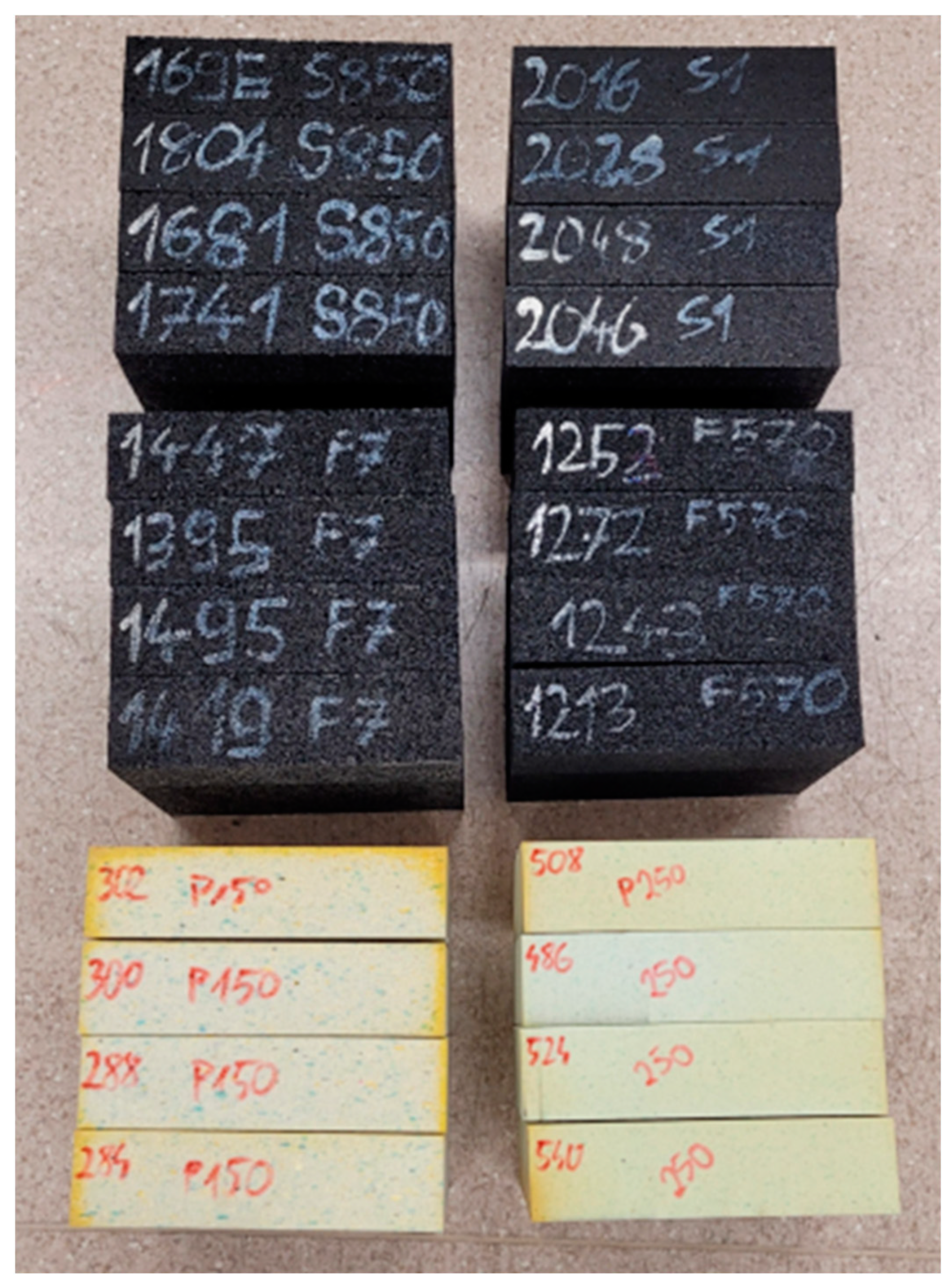
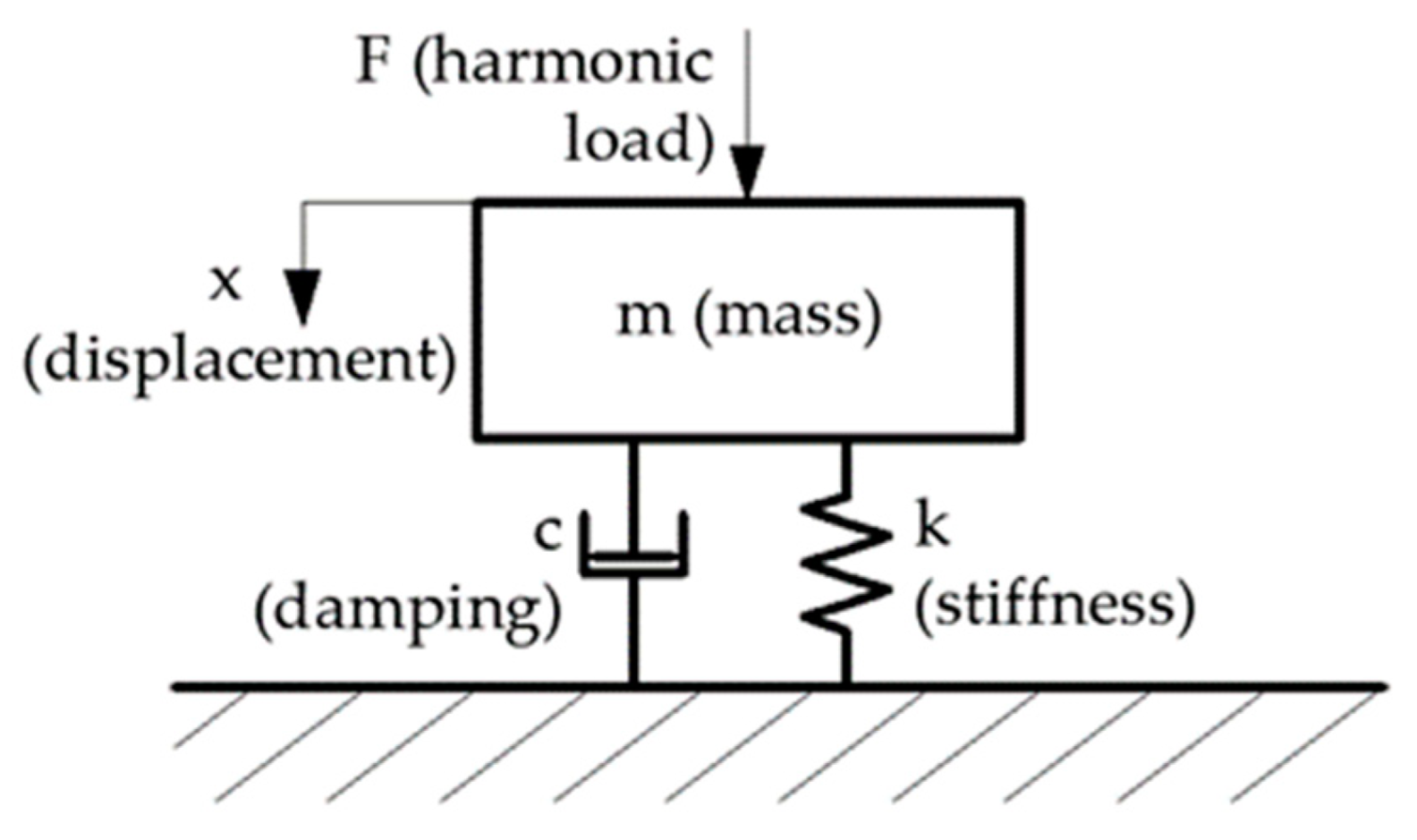
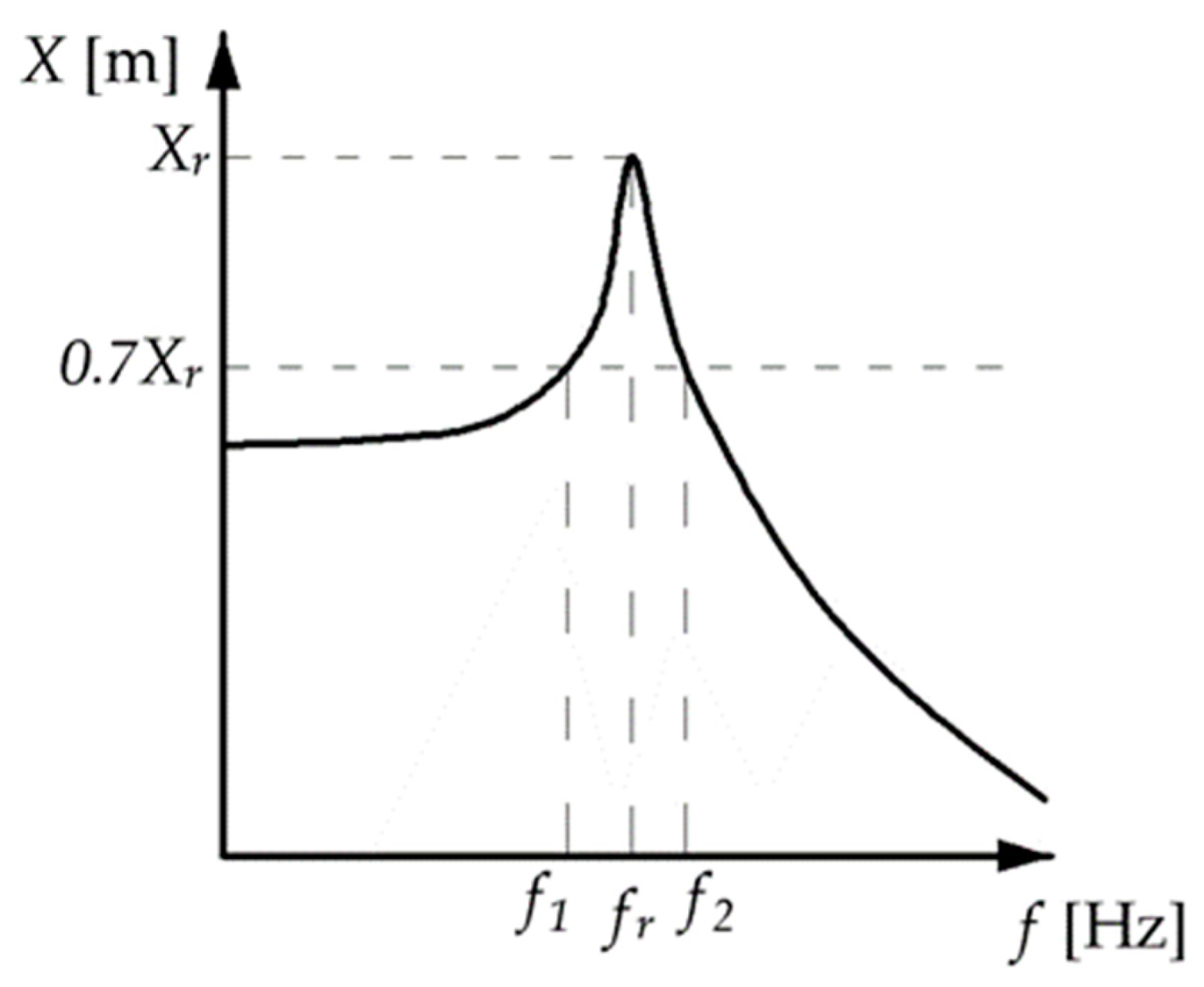
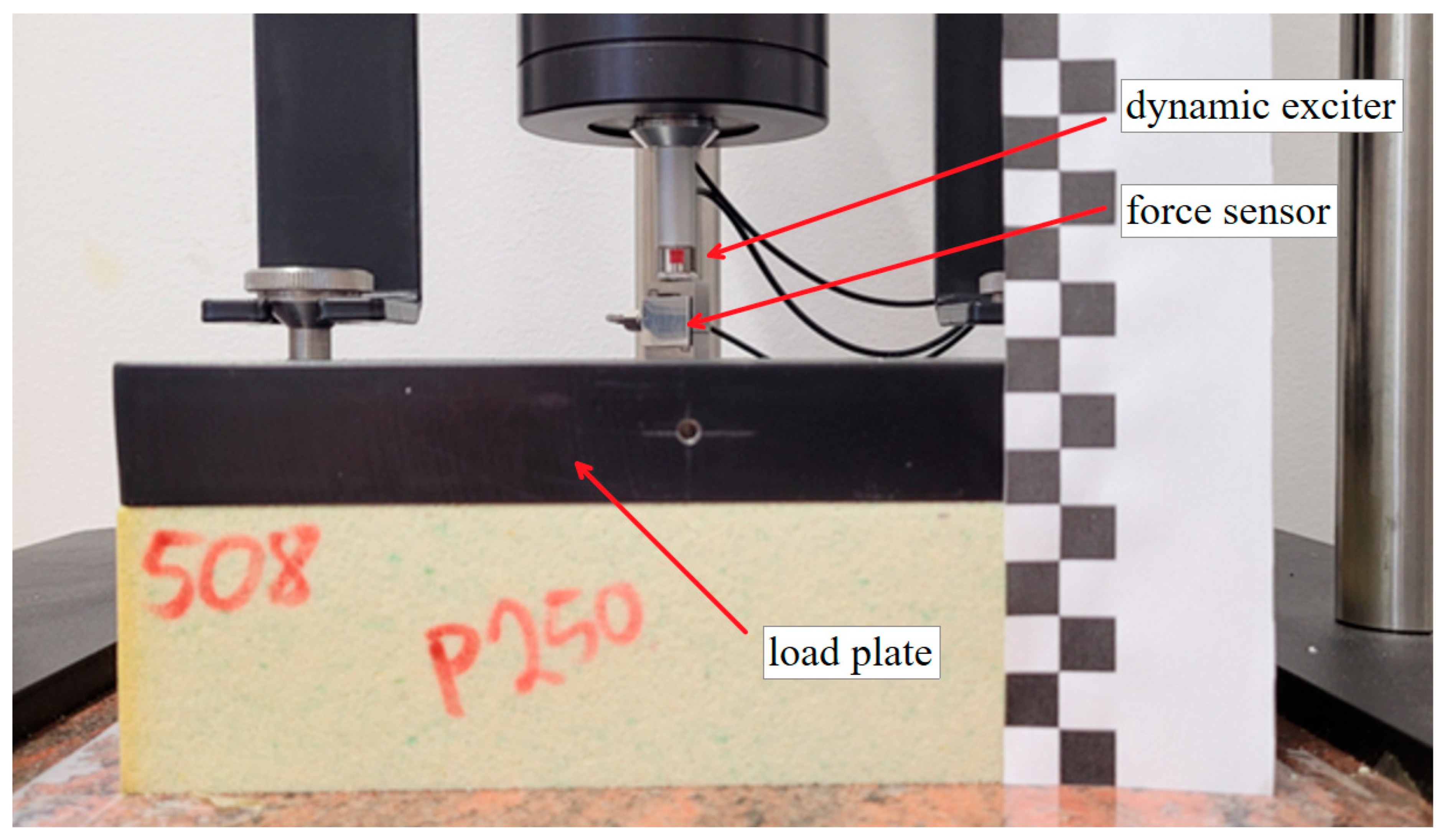

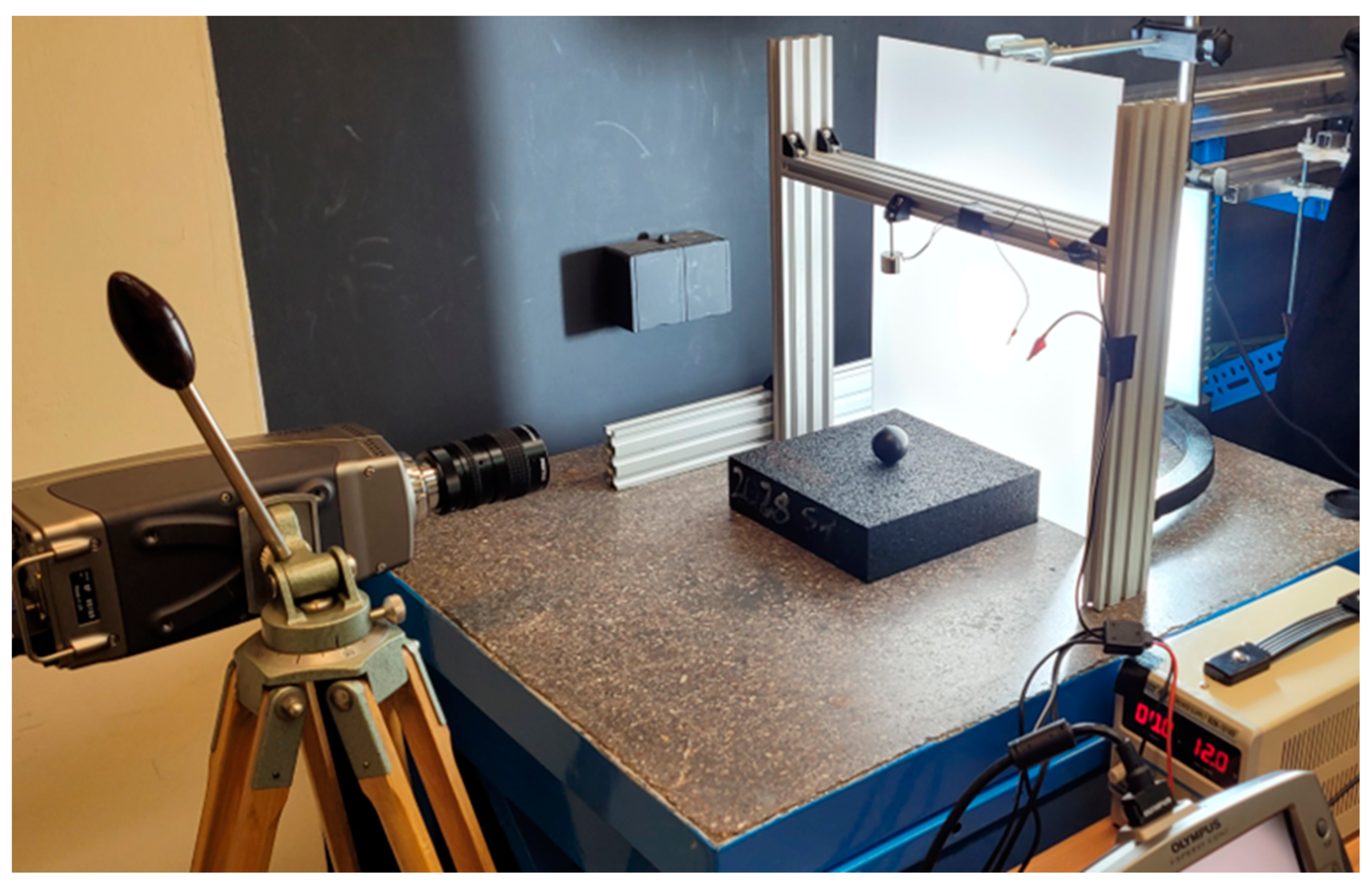
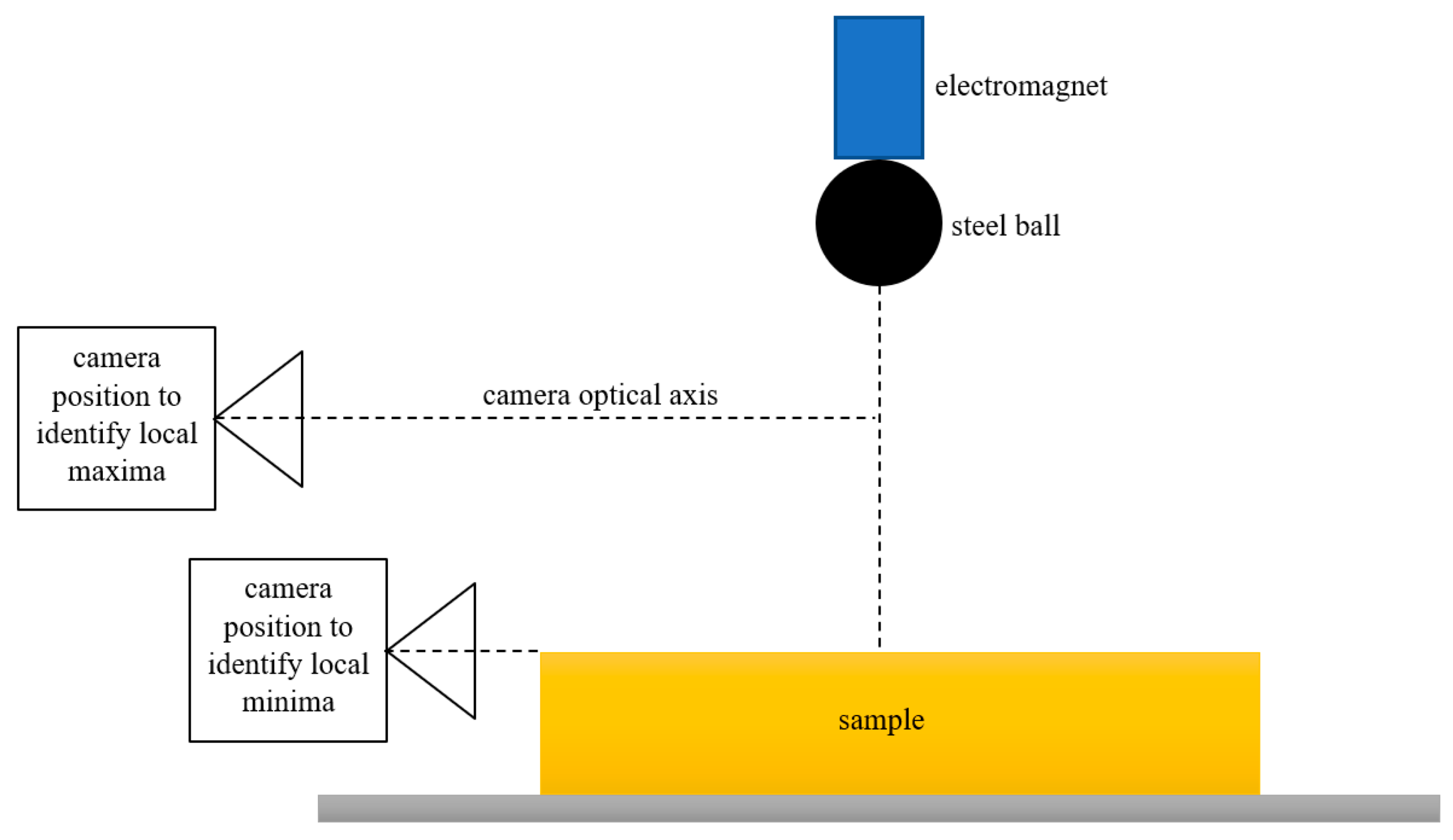
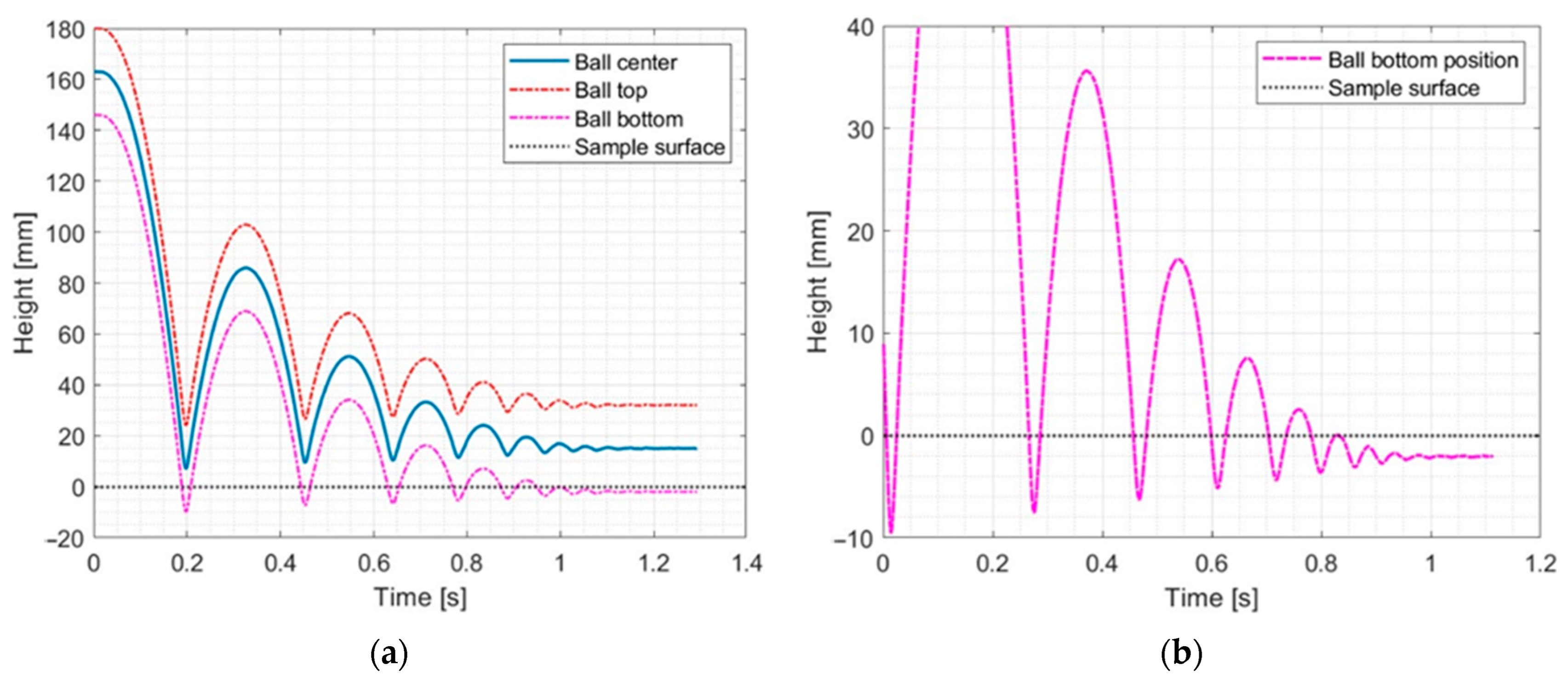

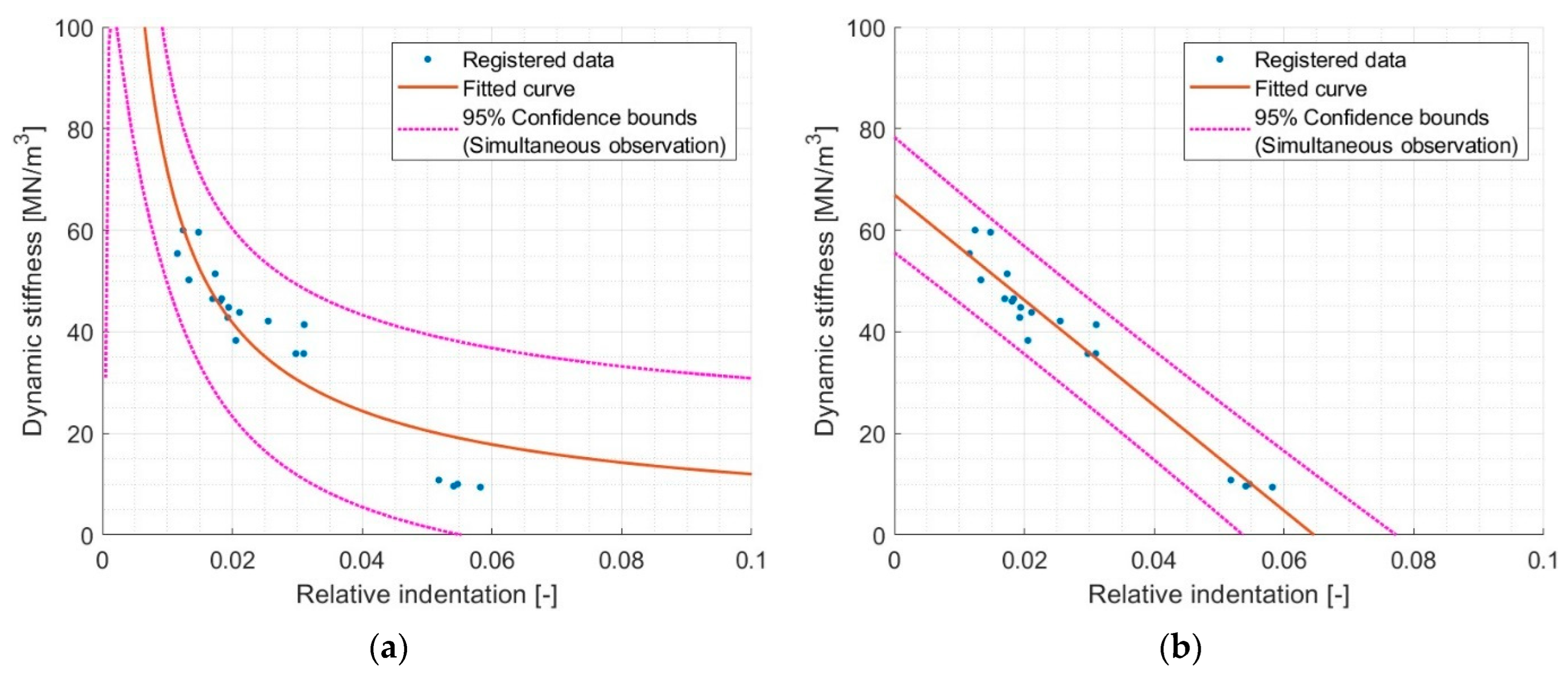

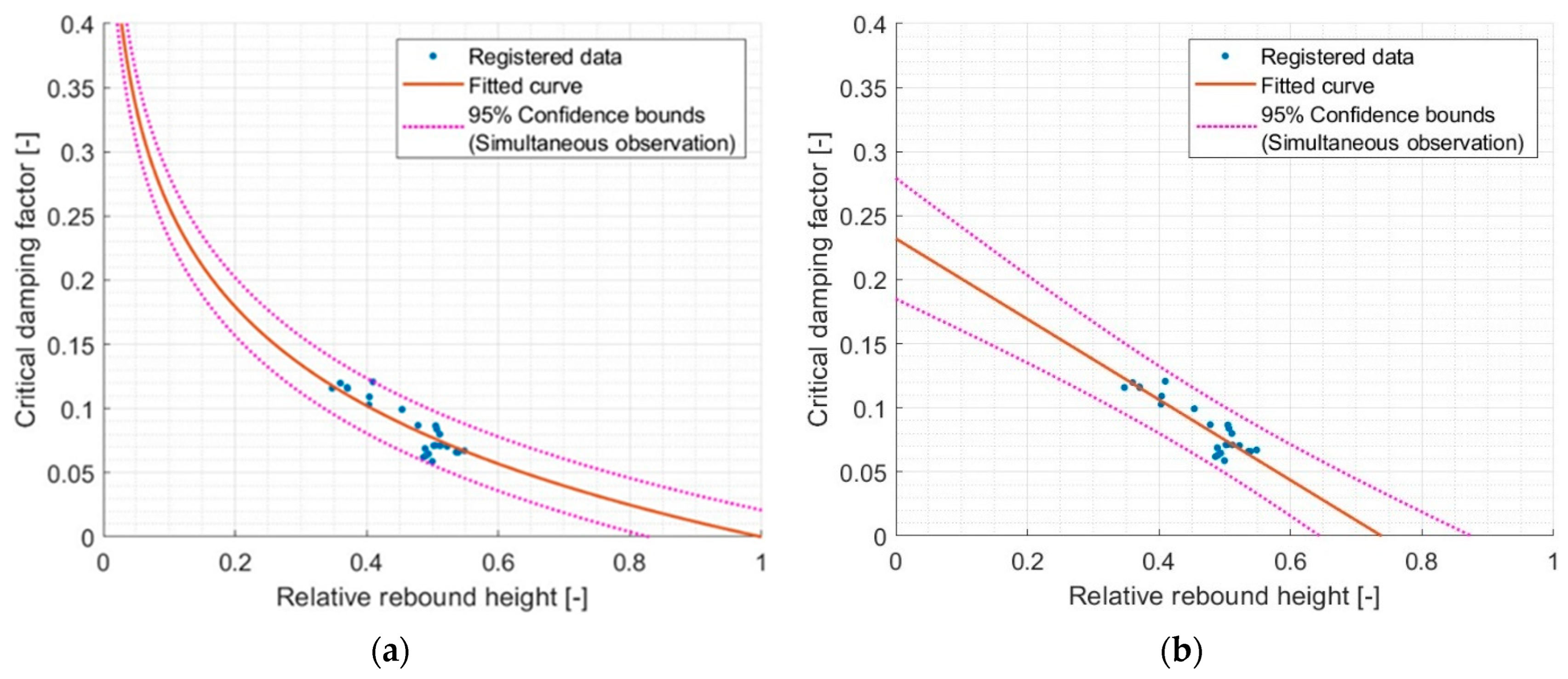
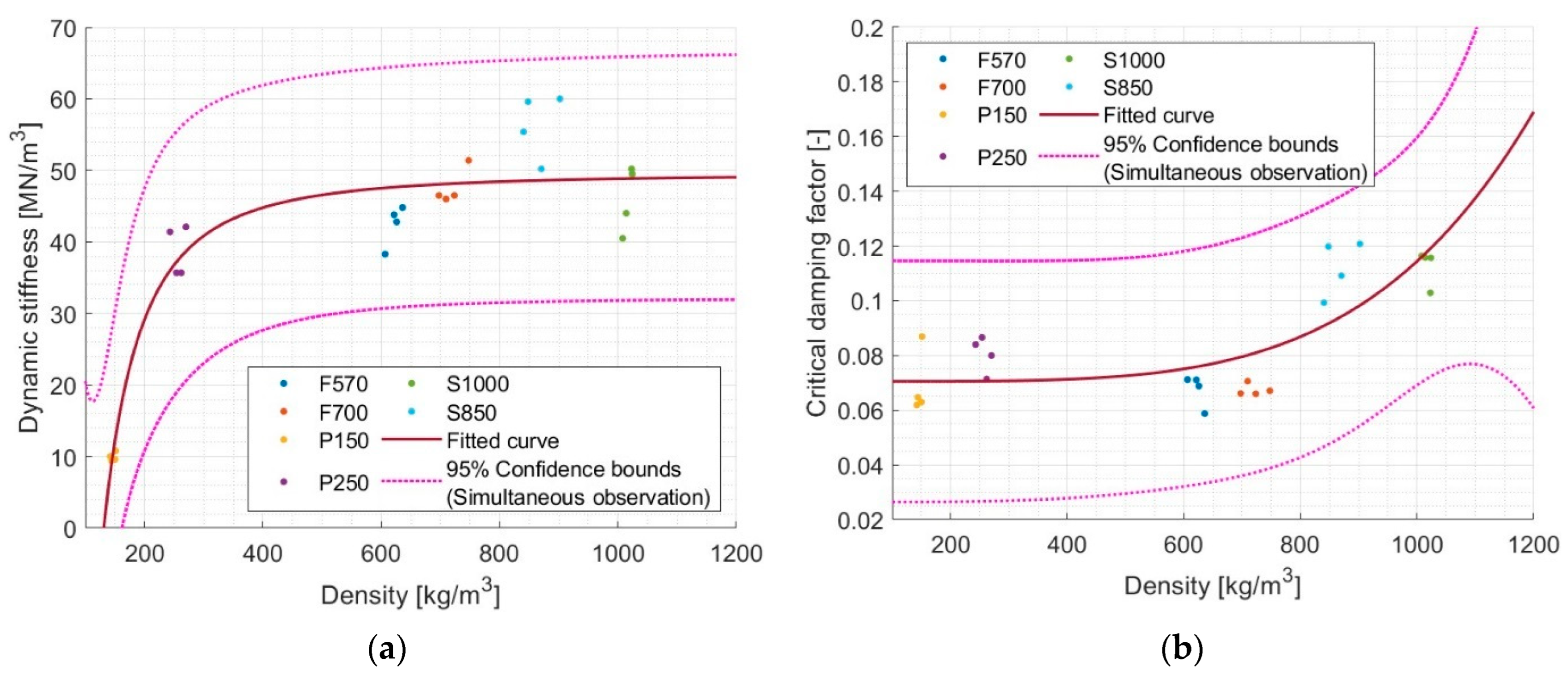
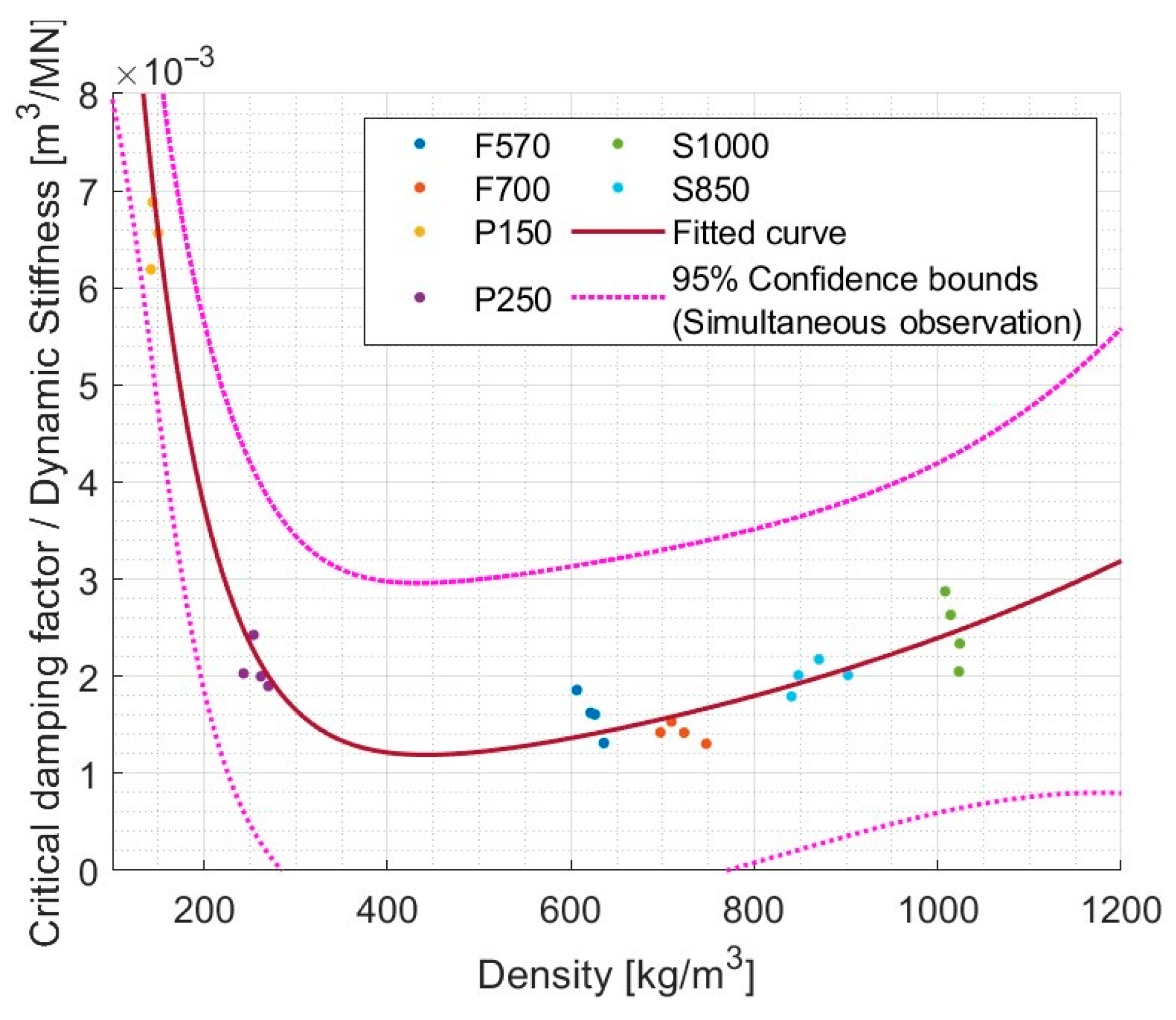


| Material Name | Sample ID | Density (kg/m3) | Density Averaged (kg/m3) |
|---|---|---|---|
| rubber granulate (S1000) | S1000_01 | 1008.0 | 1017.25 |
| S1000_02 | 1014.0 | ||
| S1000_03 | 1023.0 | ||
| S1000_04 | 1024.0 | ||
| rubber granulate (S850) | S850_01 | 840.5 | 865.25 |
| S850_02 | 848.0 | ||
| S850_03 | 870.5 | ||
| S850_04 | 902.0 | ||
| rubber granulate with rubber fibers (F570) | F570_01 | 606.5 | 622.5 |
| F570_02 | 621.5 | ||
| F570_03 | 626.0 | ||
| F570_04 | 636.0 | ||
| rubber granulate with rubber fibers (F700) | F700_01 | 697.5 | 719.5 |
| F700_02 | 709.5 | ||
| F700_03 | 723.5 | ||
| F700_04 | 747.5 | ||
| rebound polyurethane (P150) | P150_01 | 142.0 | 146.75 |
| P150_02 | 144.0 | ||
| P150_03 | 150.0 | ||
| P150_04 | 151.0 | ||
| rebound polyurethane (P250) | P250_01 | 243.0 | 257.25 |
| P250_02 | 254.0 | ||
| P250_03 | 262.0 | ||
| P250_04 | 270.0 |
| Device Name/Manufacturer | Key Feature | Key Value of Parameters |
|---|---|---|
| Dynamic exciter—Brüel & Kjær (Virum, Denmark) Mini-shaker Type 4810 | Provides sinusoidal force | Sine peak max 10 N Frequency range DC-18 kHz |
| IEPE accelerometer—MMF (Radebeul, Germany) KS78B.100 | Measures acceleration of system response | Peak acceleration 60 g (~600 m/s2) Linear frequency range (5% deviation) 0.6 Hz–14 kHz |
| Force sensor—Forsentek (Shenzhen, China) FSSM 50 N | Measures force applied to system | Max force 50 N Rated output 2.0 mV/V Hysteresis ± 0.1% R.O. (rated output) |
| Dynamic stiffness test bench | Measures resonant frequency of sample (200 mm × 200 mm × 50 mm) under load of 8 kg | Linear frequency range upper limit (5% deviation) 20–250 Hz—measured |
| Material Name | CDF (−) (95%CI) | Rf (Hz) (95%CI) | DS (MN/m3) (95%CI) |
|---|---|---|---|
| rubber granulate with rubber fibers (F570) | 0.0675 | 73.28 | 42.4 |
| (0.0581, 0.0769) | (69.24, 77.31) | (37.9, 47) | |
| rubber granulate with rubber fibers (F700) | 0.0674 | 77.61 | 47.6 |
| (0.064, 0.0709) | (74.32, 80.9) | (43.6, 51.6) | |
| rebound polyurethane (P150) | 0.0691 | 35.5 | 10.0 |
| (0.0501, 0.0881) | (33.8, 37.2) | (9.0, 10.9) | |
| rebound polyurethane (P250) | 0.0805 | 69.97 | 38.7 |
| (0.0699, 0.0911) | (64.93, 75.02) | (33.1, 44.3) | |
| rubber granulate (S1000) | 0.1127 | 76.31 | 46.1 |
| (0.1023, 0.1231) | (70.18, 82.43) | (38.7, 53.4) | |
| rubber granulate (S850) | 0.1123 | 84.39 | 56.3 |
| (0.0962, 0.1284) | (78.88, 89.89) | (49, 63.6) |
| 1st Peak/Start (95%CI) | 2nd/1st Peak (95%CI) | 3rd/2nd Peak (95%CI) | 4th/3rd Peak (95%CI) | |
|---|---|---|---|---|
| rubber granulate with rubber fibers (F570) | 0.4877 | 0.5134 | 0.5091 | 0.497 |
| (0.4703, 0.5052) | (0.4995, 0.5272) | (0.4985, 0.5197) | (0.4845, 0.5095) | |
| rubber granulate with rubber fibers (F700) | 0.5183 | 0.5549 | 0.5595 | 0.5547 |
| (0.5027, 0.5338) | (0.5356, 0.5743) | (0.5485, 0.5705) | (0.5455, 0.564) | |
| rebound polyurethane (P150) | 0.4764 | 0.4973 | 0.4819 | 0.4455 |
| (0.4625, 0.4903) | (0.4893, 0.5053) | (0.4623, 0.5014) | (0.4271, 0.4639) | |
| rebound polyurethane (P250) | 0.4935 | 0.5199 | 0.5158 | 0.4981 |
| (0.4871, 0.4999) | (0.5103, 0.5295) | (0.5063, 0.5253) | (0.4845, 0.5116) | |
| rubber granulate (S1000) | 0.3701 | 0.3763 | 0.3555 | 0.363 |
| (0.3353, 0.405) | (0.3366, 0.4159) | (0.3299, 0.3812) | (0.3131, 0.4128) | |
| rubber granulate (S850) | 0.3957 | 0.4183 | 0.4114 | 0.3902 |
| (0.3259, 0.4654) | (0.3648, 0.4718) | (0.3703, 0.4525) | (0.329, 0.4513) |
| 1st Ind. */Start (95%CI) | 2nd/1st Ind. (95%CI) | 3rd/2nd Ind. (95%CI) | 4th/3rd Ind. (95%CI) | |
|---|---|---|---|---|
| rubber granulate with rubber fibers (F570) | 0.0201 | 0.0281 | 0.0373 | 0.0451 |
| (0.0187, 0.0215) | (0.0257, 0.0304) | (0.0335, 0.0412) | (0.0406, 0.0496) | |
| rubber granulate with rubber fibers (F700) | 0.0177 | 0.0263 | 0.0323 | 0.0382 |
| (0.0167, 0.0187) | (0.0223, 0.0303) | (0.0241, 0.0404) | (0.027, 0.0494) | |
| rebound polyurethane (P150) | 0.0547 | 0.0825 | 0.1132 | 0.1375 |
| (0.0505, 0.0589) | (0.0778, 0.0872) | (0.1002, 0.1263) | (0.1218, 0.1533) | |
| rebound polyurethane (P250) | 0.0293 | 0.0415 | 0.0547 | 0.0675 |
| (0.0252, 0.0335) | (0.036, 0.0469) | (0.0453, 0.064) | (0.0567, 0.0782) | |
| rubber granulate (S1000) | 0.0084 | 0.0172 | 0.0269 | 0.0348 |
| (0.0064, 0.0104) | (0.0136, 0.0208) | (0.0205, 0.0333) | (0.0229, 0.0467) | |
| rubber granulate (S850) | 0.013 | 0.0245 | 0.0378 | 0.0479 |
| (0.0108, 0.0152) | (0.0161, 0.0329) | (0.0249, 0.0507) | (0.0324, 0.0634) |
| 1st Ind./Start | 2nd/1st Ind. | 3rd/2nd Ind. | 4th/3rd Ind. | 5th/4th Ind. | |
|---|---|---|---|---|---|
| SSE | 747.6245 | 788.0932 | 911.2817 | 969.5523 | 1059.64 |
| R2 | 0.858681 | 0.851032 | 0.827746 | 0.816732 | 0.799703 |
| RMSE | 5.829488 | 5.985183 | 6.435984 | 6.638566 | 6.940134 |
| 1st Peak/Start | 2nd/1st Peak | 3rd/2nd Peak | 4th/3rd Peak | |
|---|---|---|---|---|
| SSE | 0.001982 | 0.002138 | 0.002646 | 0.003137 |
| R2 | 0.814922 | 0.800411 | 0.752947 | 0.707063 |
| RMSE | 0.009492 | 0.009857 | 0.010967 | 0.011942 |
Disclaimer/Publisher’s Note: The statements, opinions and data contained in all publications are solely those of the individual author(s) and contributor(s) and not of MDPI and/or the editor(s). MDPI and/or the editor(s) disclaim responsibility for any injury to people or property resulting from any ideas, methods, instructions or products referred to in the content. |
© 2024 by the authors. Licensee MDPI, Basel, Switzerland. This article is an open access article distributed under the terms and conditions of the Creative Commons Attribution (CC BY) license (https://creativecommons.org/licenses/by/4.0/).
Share and Cite
Nering, K.; Nering, K. Alternative Method for Determination of Vibroacoustic Material Parameters for Building Applications. Materials 2024, 17, 3042. https://doi.org/10.3390/ma17123042
Nering K, Nering K. Alternative Method for Determination of Vibroacoustic Material Parameters for Building Applications. Materials. 2024; 17(12):3042. https://doi.org/10.3390/ma17123042
Chicago/Turabian StyleNering, Krzysztof, and Konrad Nering. 2024. "Alternative Method for Determination of Vibroacoustic Material Parameters for Building Applications" Materials 17, no. 12: 3042. https://doi.org/10.3390/ma17123042






